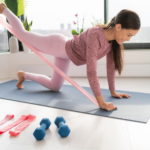Yoga has become an increasingly popular treatment option to combat depression. Two key advantages to consider when considering it as an approach are exercise and meditation; both have proven useful against depression in various studies. More and more evidence supports its use as an antidepressant treatment option.
Time magazine published an article several years ago entitled It’s Official: Yoga Helps Depression that pointed out recent research which indeed indicated yoga could help decrease participants’ depression levels during this study.
Below we’ll further examine several studies mentioned in Time’s article as well as others.
To be specific, this article serves as a comprehensive overview of Yoga for Depression: a complete guide.
I will explore depression in general and present statistics related to it, then present findings of studies which explored whether yoga could help treat depression; I will then present reasons for considering yoga a potential treatment method for depression.
I will present a scientific-based yoga sequence designed to assist those suffering from depression.
I will cover in this article: What Is Depression? 2 How Can Yoga Affect Depression? 3 Is Yoga Effective Treatment for Depression 4 Asana Poses and Sequence for Depression 5 Yoga as a Way out from Stress and Depression
What Is Depression (MDD)
According to WebMD: “Depression (also referred to as major depressive disorder) is a mood disorder in which you experience consistent sadness or lack of interest in life.”
They indicate that most people experience feelings of sadness from time to time; however, when intense sadness – including helplessness, hopelessness and worthlessness — persists for several days to weeks and prevents you from living your life as usual, this could be more than mere sadness; they state it could be clinical depression which they note can be treated.
If these feelings seem familiar to you, that could be because depression is much more widespread than you realize.
Below are a few statistics regarding depression:
Statista reports depression to be one of the most widespread forms of mental illness in America; 16 million adults experienced at least one major depressive episode annually according to Healthline estimates.
According to data compiled by the National Center for Health Statistics between 2011 and 2014, around one in ten (12+) people aged 12 or more took antidepressant drugs within the last month.
According to research conducted by the National Institute of Mental Health, women are significantly more likely than men (5.3%) to experience major depressive episodes (8.7% vs 5.3% respectively), whilst young adults aged 18-25 years have higher chances of major depressive episodes (13.1%) than other age groups.
Helpline has published an incredibly insightful piece entitled Signs of Depression that offers 8 signs that indicate depression (helpless outlook, uncontrollable emotions and lack of interest being some). Furthermore, each topic includes a quote from an individual experiencing that feeling.
Simply knowing about depression’s signs may make it easier for anyone experiencing it or their loved ones, including medical practitioners, to recognize whether medical help may indeed be required.
How does yoga combat depression?
Anyone who has practiced yoga under an experienced yoga teacher likely knows it involves more than simply stretching; breathing alone cannot give sufficient benefits in comparison.
Yoga provides numerous health and mental wellbeing advantages and attracts so many practitioners worldwide due to being composed of four essential elements. These four components include:
Each yoga class encompasses postures, breathing exercises, relaxation exercises and meditation as essential elements. Some instructors may place more focus on one or more components depending on their chosen yoga style.
Studies are increasingly investigating yoga’s ability to help those experiencing depression. According to Harvard Mental Health Letter, key health benefits from practicing yoga include:
Yoga can reduce stress-induced impacts, help with depression and increase energy. According to an article entitled How Might Yoga Help Depression? A Neurobiological Perspective by its authors, they detail how Yoga may assist depression and anxiety symptoms:
Yoga uses slow rhythmic breathing practices and meditation/relaxation practices to elicit feelings of peace, well-being, stress tolerance and mental focus that may reduce depression, anxiety stress and rumination.
As an exercise for mindful, low impact movement, yoga may offer antidepressant and anxiety relieving properties.
Let us now examine some key scientific studies which demonstrate how yoga can assist with depression.
Study 1 (Iyengar yoga and depression)
A small University of California study suggests that attending yoga classes just twice each week, even just Iyengar yoga, may help alleviate depression due to specific asanas being practiced that could prove effective against it.
Study participants included 28 adults between ages of 18-64 experiencing mild levels of depression. Half were assigned to an Iyengar yoga group that met weekly for 1-hour Iyengar yoga class while those assigned as controls received no intervention whatsoever.
Morning Iyengar yoga classes emphasized postures designed to ease depression:
Each class ended with chest opening relaxation postures for deep backbends and inversions, backbends, standing poses, inversions and backbends.
After five weeks, those participating in yoga had significantly lower depression and anxiety levels as well as an improved mood compared to their counterparts in other study groups, appearing halfway through and remaining for the entire length of study.
Study 2 (Ashtanga Yoga and Depression)
An Iran study suggests that attending yoga classes only two times each week for two months for women specifically may help combat their depression symptoms.
This study involved 34 women aged 31 on average who all experienced some form of depression. Half were assigned to a yoga group that took two 90-minute Ashtanga yoga classes per week while another group served as controls with no intervention whatsoever.
The authors noted:
Yoga classes help individuals develop greater body awareness through yoga postures (Asana). Raising awareness of tension within one’s own body and learning ways in which this tension may be reduced may serve to build self-confidence by providing control.
After two months, women in the yoga group experienced significant decreases in anxiety levels compared to those who received traditional medical therapy, leading researchers to draw the following conclusion: “This research suggests that yoga may provide effective anxiety management therapy in women and has potential as an additional therapy tool or replacement medication”.
Studies (3) (Hatha yoga and Depression)
According to one San Fransisco study, taking two 90-minute Hatha yoga classes twice every week significantly helped lower depression symptoms.
Study participants averaged 43 years old with mild-to-moderate major depression were divided into two groups; half participated in yoga group while those assigned to control group received no intervention whatsoever.
Hatha yoga classes included classic breathing techniques, mindful body postures and deep relaxation practices to promote overall well-being and alleviate depression. There were also postures designed specifically to open up chests – another means by which depression could be tackled more efficiently.
At eight weeks, those participating in the yoga group had significantly decreased their levels of depression.
The authors noted that Hatha yoga may help alleviate depression because of its therapeutic components, including:
“Yoga involves physical postures and mindful exercises with nonjudgmental approaches that observe and address one’s limitations in an non-judgemental manner, the regulation of breathing patterns to promote alert calmness, as well as deep relaxation through restorative poses at its conclusion.”
Study 4 (Savasana and Depression) An Indian research project demonstrated that simply practicing Savasana alone can significantly decrease depression symptoms.
Study participants included 50 University students randomly assigned either to the yoga or control groups; those in one would practice daily savasana for 30 days while their counterparts received no intervention whatsoever.
After 30 days in the yoga group, participants had significantly decreased their levels of depression when compared to those in the control group.
Studies are increasingly finding yoga to be effective against depression. One possible reason could be its exercise component – which has long been recognized for helping treat symptoms of depression. Furthermore, yoga practiced among a community creates shared experience as well as being mind/body stimulating.
Lets have a deeper discussion about why yoga can be helpful against depression.
- Yoga Is A Form of Exercise Exercise has long been prescribed as therapy for depression; and more and more studies support this claim. For example, one well-cited article entitled Physical activity, exercise, depression and anxiety disorders cites these facts:
“Physical activity and exercise have long been perceived to have positive effects on mood and anxiety; many studies document an association between physical activity, general wellbeing and state of mood or anxiety.”
Recent well-controlled studies demonstrate the potential efficacy of exercise training as an intervention, at least in cases of major depression and panic disorder. “
Given that yoga provides physical benefits, practicing alone may help alleviate depression in individuals suffering from it.
Exercise can help with depression because physical exercise causes our body to release chemicals known as endorphins that provide temporary happiness and lift our spirits.
WebMD states that endorphins reduce pain perception while simultaneously creating positive feelings in your body, so pay attention when exercising or attending yoga class and notice how good you feel afterwards; remembering and holding onto this feeling will keep you coming back for more classes in future!
- Yoga Can Meet Your Needs
There is an assortment of types of yoga from which to select; each has different advantages for practicing it. One style may offer gentler or deeper meditation experiences than others.
This means they can be tailored specifically to suit an individual’s needs and desires.
Studies conducted above explored three forms of yoga. Each type was more physically demanding than another but all were found to help those dealing with depression.
- Yoga Is About Mindfulness Yoga requires us to stay present, mindfully experiencing feelings and sensations at their moment of occurrence without judgment from outside sources – which is the essence of mindfulness.
Merriam Webster defines mindfulness as the practice of being present with one’s thoughts, emotions and experiences on an ongoing basis without judgment or self-judgment.
Mindfulness therapy has quickly become one of the go-to treatments for depression. A study entitled Effect of Mindfulness-Based Therapy on Anxiety and Depression further details this phenomenon:
Mindfulness practices operate under the fundamental assumption that experiencing each present moment without judgment or blame can effectively counter the adverse effects of stressors, while an over-focus on either past or future responses when dealing with stress can contribute to feelings of isolation or detachment.”
Yoga offers many methods for combatting depression and anxiety; one form is mindfulness practices which involve anchoring our minds to the present through breath control, in particular. Through such practices we may also find some relief from dealing with stressful situations off of the mat.
- Yoga classes provide an environment of community Belonging to a group may help those suffering with depression feel like part of an ecosystem – and interestingly enough, this may extend to all of us!
Psychology Today published an article which further illustrated this point, outlining two studies which demonstrated how group work increases motivation levels and prolongs projects.
One study divided participants into two groups depending on which color sticker was assigned them; those assigned with identical stickers spent more time trying to solve math problems they were assigned as part of this grouping.
According to Psychology Today author of an article:
Put together, these studies illustrate that even simple relationships founded solely on random factors (like sharing birthdays or being randomly assigned into groups) are enough to induce feelings of warmth and motivation between people.
People tend to adopt the goals of those they feel close with, especially if those goals align with theirs.
Studies conducted have provided convincing proof of joining groups and associating with them can help alleviate depression.
Researchers came to this conclusion after conducting extensive fieldwork:
“Membership in groups generally confers numerous mental health advantages; more sources exist, the less depressed (or happier) an individual is.”
As most depressed patients prefer non-drug therapies and find therapy stigmatizing, this study’s contribution lies in reinforcing evidence for alternative and social interventions which could prove significantly more attractive for many of them.
And so if we consider yoga classes and studios as collective entities, this research further underscores the role of a yoga instructor.
Not only can our instructors lead students through a sequence of poses and through peaceful breathwork, they must also create an atmosphere in which our students feel secure and at home.
Asana Poses and Sequence for Depression
These asana poses and sequences were employed during a recent Hatha yoga study for depression relief; each practice should take approximately 50 minutes.
Half Waist Wheel Poses.
This pose can be performed sitting or standing. When sitting, find an appropriate chair and raise your left arm while bending sideways towards right for a stretch on left side before returning back into neutral and repeating on other side.
On each breath inhale, note if you can sense an increase in stretch depth.
Continue to take deep, cleansing breaths as desired and repeat as often as desired.
Benefits This stretching exercise will provide the side body with relief of tension build-up.
Now is an opportune moment to try the Half Wheel Pose on either feet. Bring both hands back towards your lower back with arms spread wide apart before gently leaning back with neck extended backwards allowing your head to also bend back.
This can be an amazing chest opener. However, if you suffer from lower back discomfort be careful not to arch too heavily when performing this move.
If the pose feels comfortable for you, attempt bending backward by trying to bring your chest closer to the ceiling instead of tilting forward from your lower back. Doing this helps open your chest more effectively than leaning from its corner position.
Benefits
This chest opener can help us open up our chest area, especially if we find ourselves slightly hunching over or having shoulders forward.
Hands to feet pose
Uttanasa, one of the more well-known poses found across various styles of yoga, features in numerous variations which help stretch and calm both lower backs as well as minds.
If this pose is new to you, here are a few guidelines:
Position your feet hip-distance apart. Bend both knees slightly and fold forward; this pose can help alleviate lower back discomfort such as herniated discs by keeping your knees bent throughout. When performing this pose, bend knees as far as desired while relaxing your head and neck completely.
Allow your fingers to touch the floor (or hold onto either elbow). Benefits This pose is highly beneficial in lengthening all the muscles along your spine – something which comes as a relief after hours spent sitting or standing!
By folding forward, this pose helps relieve tension, calm the mind, and decrease anxiety levels.
Cobra Pose Its Cobra pose is an approachable and frequently practiced pose in yoga classes.
Lay on your belly with both hands next to your chest. Inhale and push gently off of the floor as you lift your chest off of it with inhales. Lifting gaze can also help open up chest space; but be wary not to extend too far if experiencing pain; benefits. These exercises not only open up chest space but can strengthen lower back muscles as well.
Bow Pose
This stretch is more intense than Cobra Pose.
Lay on your belly on the floor, with knees bent and neck arched gently back. If flexible enough, hold onto ankles if possible for this exercise that helps open your chest as well as strengthen lower back muscles. It offers several key benefits.
Shoulder Stand; typically seen towards the end of yoga classes
Lies down on your mat and raise both legs until they are perpendicular to the floor or you could place your legs against a wall and keep your back flat against it.
Benefits Inversion therapy can help soothe your nervous system by activating the parasympathetic nervous system, leading to feelings of relaxation.
Fish Pose This pose can be performed either with legs straightened out or bent knees and soles of feet on the floor.
Assume an extended position while lying on your mat. Place both hands (palms down) under your back with fingers pointing at your spine and press gently down onto them as you gradually raise and arch your chest until comfortable; keep weight balanced on elbows throughout this exercise for maximum benefits. Eventually this should give a good chest opener!
Bridge pose can help alleviate lower back discomfort. Here’s some guidance if this pose is unfamiliar:
Position yourself with feet flat on the floor. Inhaling, press your feet firmly against it while simultaneously raising your pelvis (lifting heels is optional). Benefits
A simple yet common chest opener found throughout most yoga classes.
Child’s Pose
Child’s pose is an extremely gentle and relaxing yoga pose which makes for an excellent way of dealing with stress and anxiety.
Benefits Resting your forehead on a mat can have a calming and grounding effect on the brain, so if anxiety means troubling thoughts are running through your mind, this pose could help soothe them away and alleviate some stress.
Twisted Pose
This pose can help stretch and lengthen muscles in your lower back. Simply relax into it as gently or deeply as feels right for you!
If this pose is unfamiliar to you, here are a few key instructions:
Lay on your back with feet flat on the floor. Bring knees up toward chest and allow them to fall to either side as shown above, while keeping arms at shoulder level and turning your head away from where your knees are facing.
Make this stretch more intense by placing arms around knees and encouraging them to come closer together, thus encouraging further extension. Benefits This pose is excellent for relieving any tension build-up in our lower back area – perfect if we’ve spent all day sitting behind a computer screen!
Camel pose
Kneel on the ground and bring both hands onto your lower back. Slowly arch back so that your chest lifts. If flexible enough, hold onto both heels.
15 minutes: Savasana Whilst lying back comfortably with your eyes closed and arms outstretched in palm up position and legs stretched with feet rotated out slightly – take 15 minutes of total relaxation in Savasana for optimal relaxation and restoration.
Are You Searching for an Audio Guided Meditation Practice While in Savasana? Look No Further
Yoga for Stress and Depression
Are You Are looking for an online Yoga course, MindBodyGreen offers several paid courses worth checking out; here are 3 that may interest you:
Anxiety Control | How To Beat Stress And Depression
Related Topics.
Which yoga style should I practice to reduce anxiety and depression symptoms? Yoga has long been recognized for its ability to ease symptoms associated with anxiety and depression. There are various styles available; depending on your unique requirements and desires some may prove more beneficial than others.
For additional reading on yoga’s benefits for anxiety and depression relief, my article can provide useful details: “Yoga Can Help: 15 Blissful Types to Try”)
Which Yoga Poses Can Be Effective in Treating Depression? Anxiety and depression often have unpleasant physical side effects that include tension in the form of stiffness in various body areas. Yoga postures have the ability to stretch out tightness from our bodies by stretching and lengthening us out through their unique sequence of postures, thus relieving tension from those areas where tension has built up over time.
Every form of yoga offers benefits to relieve tension and stiffness as well as help calm the mind, so it is crucial that you find what suits your unique situation best.
To gain more information, you may find my article, How Yoga Helps Anxiety & Depression: 15 Delightful Types to Try (plus 15 Blissful Alternatives), useful.







